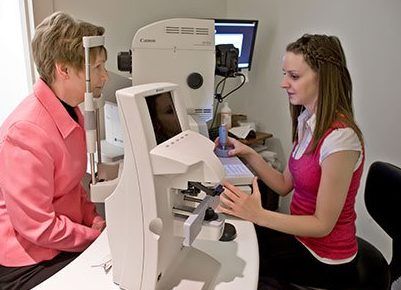Detection of Eye Disease
Early Detection is Key
Doctors of Optometry train for a minimum of seven years to provide you with the best eye care available. All of our Calgary and area optometrists are TPA-certified, meaning they have taken additional training dealing with thediagnosis and treatment of eye disease.
Having an annual eye exam is extremely important in order to protect your eyesight from disease. These visits help your eye doctor detect small, subtle changes that might indicate a risk factor or the need for further testing.

Optic Nerve
The optic nerve collects the signal received by the cells in the retina, and transmits it to your brain for processing. Diseases of the optic nerve can have severe consequences to vision. Glaucoma is one such disease.
Retina
Your doctor needs to look at the inside of your eyes, at the back, to check that they are healthy and not showing any signs of disease. Many eye diseases, if detected early, can be treated successfully without significant vision loss.
Glaucoma
Detection of eye disease in the early stages is critical to the preservation of your vision. Certain eye diseases such as glaucoma have no symptoms early on, and are frequently diagnosed in our office during a routine eye exam. Risk factors such as family history, eye injury, or elevated eye pressures may increase your risk of glaucoma.
Diabetes
Diabetes is a leading cause of blindness, yet only half of the people with diabetes know they have the disease. Bleeding inside the eye may be the first sign of its presence. The major cause of blindness in people with diabetes is called diabetic retinopathy. This condition causes damage to the small blood vessels that supply the retina at the back of the eye. Excessive leakage of these blood vessels causes widespread damage and possible loss of vision.
Macular Degeneration
The leading cause of non-preventable blindness in people over 65 is called age-related macular degeneration (AMD). The macula is located in the center of the retina and is responsible for giving us sharp, clear, central vision we use to resolve fine detail. AMD causes a slow degenerative process in the macula which can cause blurring or distortion of central vision. Risk factors for AMD include smoking, sunlight exposure, and family history. Speak to our eye doctors to learn more about AMD.
Cataracts
This common condition happens when the lens of the eye becomes cloudy, causing a reduction in clarity and contrast. The most common form of cataract is age-related, but it can develop at younger ages and some types are even found at birth. Once a cataract starts to noticeably affect vision it can be removed surgically and replaced with a clear implant to restore vision back to normal.


